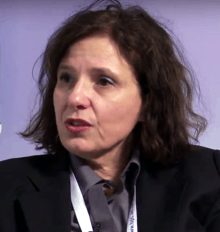Doris Taylor
| Doris Taylor FACC, FAHA | |
|---|---|
 Doris Taylor in 2012 | |
| Born | San Francisco |
| Nationality | American |
| Alma mater |
Mississippi University for Women, University of Texas Southwestern Medical Center |
| Known for | regenerative medicine |
| Scientific career | |
| Institutions |
Duke University, Texas Heart Institute |
Doris Anita Taylor, Ph.D., FACC, FAHA is an American scientist working in regenerative medicine and tissue engineering. She is Director, Regenerative Medicine Research and Director, Center for Cell and Organ Biotechnology at the Texas Heart Institute in Houston, Texas.
Biography
Taylor was born in San Francisco and lived in Germany with her parents and two siblings, where her father was in the military. When Taylor was 6 years old, her father was diagnosed with cancer, and the family moved to Texas to seek medical treatment. Experiencing her father's death from cancer, and caring for her brother, who has schizophrenia, led her to a career in medical research.[1][2]
Taylor earned her B.S. from Mississippi University for Women in Biology and Physical Sciences and earned her PhD in Pharmacology from the University of Texas Southwestern Medical Center, Dallas, Texas.[3] She did her post-doctoral studies at Albert Einstein College of Medicine in the Bronx, New York, where she first worked with tissue engineering, growing heart muscle cells in the laboratory.[4]
She was on the faculty of Duke University from 1991 to 2007, on the faculty of the University of Minnesota from 2003 to 2012, and joined the Texas Heart Institute in 2012. As of 2014 she retains an adjunct professor role at University of Minnesota and is an adjunct professor at Texas A&M University.[3]
Research
In 2008, Taylor's team published a paper in Nature Medicine showing that her team could create beating rat hearts using tissue engineering;[5] the work was called a "landmark". The lab first stripped the cells away from a rat heart (a process called "decellularization") and then injected rat stem cells into the decellularized rat heart.[6]
Taylor also is conducting research which has uncovered differences in the underlying framework of male and female hearts and other vital organs.[7]
References
- ↑ Maggie Galehouse (January 23, 2013). "Saving lives with help from pigs and cells". Houston Chronicle.
- ↑ Texas Medical Center Press Office. March 18, 2014 TMC Spotlight: Texas Heart Institute's Doris A. Taylor, Ph.D.
- 1 2 Doris A. Taylor page at THI
- ↑ Krista Tippett for On Being. September 30, 2010 Doris Taylor — Stem Cells, Untold Stories
- ↑ Ott, HC; et. al (February 2008). "Perfusion- decellularized: Using Nature's Platform to Engineer Bioartificial Heart". Nat Med. 14 (2): 213–21. doi:10.1038/nm1684. PMID 18193059.
- ↑ Lawrence K. Altman (January 13, 2008). "Researchers Create New Rat Heart in Lab". The New York Times.
- ↑ "Who has the softer heart?". 60 Minutes. May 25, 2014.